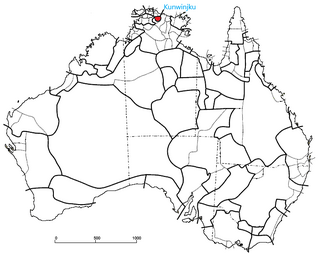The Jawoyn, also written Djauan, are an Australian Aboriginal people living in the Northern Territory of Australia. The Bagala clan are of the Jawoyn people.

The Kunwinjku people are an Australian Aboriginal people, one of several groups within the Bininj people, who live around West Arnhem Land to the east of Darwin, Northern Territory. Kunwinjku people generally refer to themselves as "Bininj" in much the same way that Yolŋu people refer to themselves as "Yolŋu".
The Garrwa people, also spelt Karawa and Garawa, are an Aboriginal Australian people living in the Northern Territory, whose traditional lands extended from east of the McArthur River at Borroloola to Doomadgee and the Nicholson River in Queensland.
The Barungguan are an Aboriginal Australian people of the Cape York Peninsula of Northern Queensland. The name is associated with three languages: Ganganda, Umpithamu and Morrobolam.
The Totj were an indigenous Australian people of far northern Queensland.
The Unjadi (Unyadi) were an indigenous Australian people of the Cape York Peninsula of northern Queensland.
The Mbewum were an indigenous Australian people of the Cape York Peninsula of northern Queensland. They were dispossessed and became extinct soon after colonization.
The Ngarinman or Ngarinyman people are an Aboriginal Australian people of the Northern Territory who spoke the Ngarinyman language.

The Arabana, also known as the Ngarabana, are an Aboriginal Australian people of South Australia.
The Malngin are an Aboriginal Australian people of the Kimberley region of Western Australia. The Malngin language was a dialect of Gurindj.
The Yankunytjatjara people, also written Yankuntjatjarra, Jangkundjara, and other variants, are an Aboriginal Australian people of the state of South Australia.
The Wikatinda were an indigenous Australian people of the Cape York Peninsula of northern Queensland. They were one of the Wik peoples, but their language is unattested.
The Kokomini (Gugumini) are reported to have been an indigenous Australian people of the state of Queensland, though some indications suggest the term may refer to a loose confederation of tribal groups.
The Yindjilandji are an indigenous Australian people of the Northern Territory.
The Ngaliya (Ngalia) are an indigenous Australian people of the Northern Territory who speak a dialect of the Warlpiri language. They are not to be confused with the Ngalia of the Western Desert.
The Iwaidja are an indigenous Australian people of the Northern Territory.
The Marra, formerly sometimes referred to as Mara, are an Aboriginal Australian people of the Northern Territory.
The Wambaya people, also spelt Umbaia, Wombaia and other variants, are an Aboriginal Australian people of the southern Barkly Tableland of the Northern Territory. Their language is the Wambaya language. Their traditional lands have now been taken over by large cattle stations.
The Mudburra, also spelt Mudbara and other variants, are an Aboriginal Australian people of the Northern Territory.
The Wagiman, also spelt Wagoman, Wagaman, Wogeman, and other variants, are an Aboriginal Australian people of the Northern Territory.